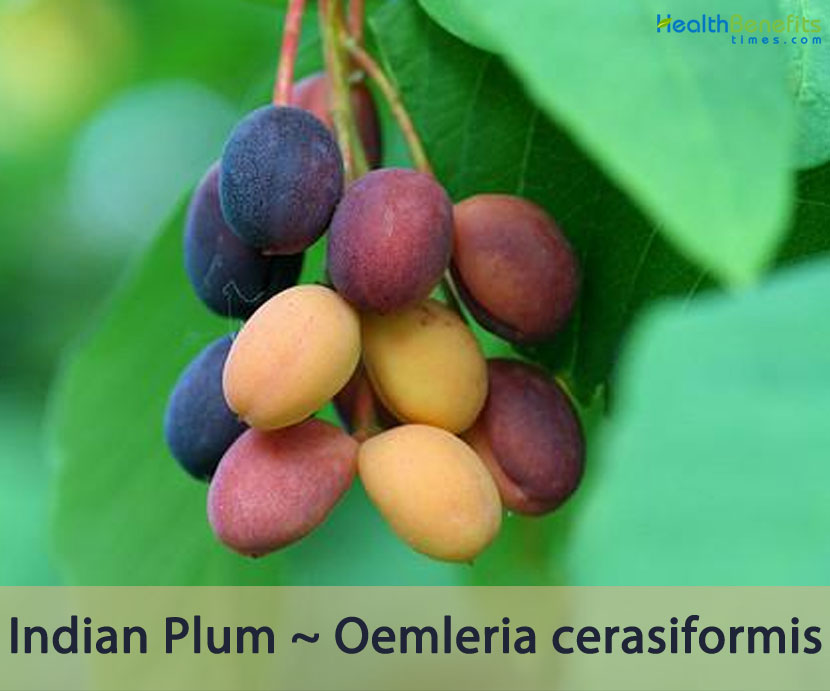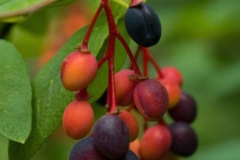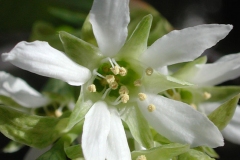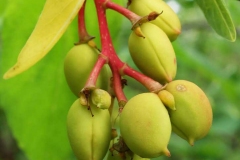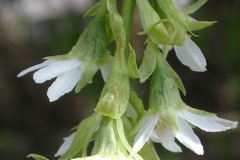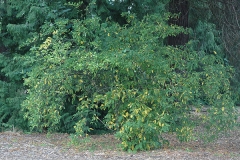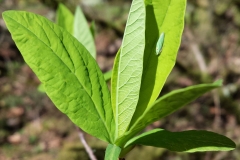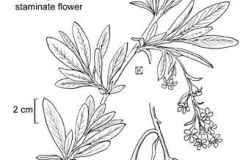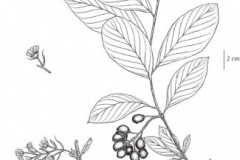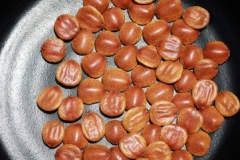Some of the well-known common names of the plants are Oregon plum, Indian peach, Osoberry, bird cherry. Genus name honors Augustus Gottlieb Oemler (1774-1852), German-American pharmacist and naturalist. Specific epithet from Latin means in the shape of a cherry in reference to the small plum to cherry-like fruits. The fruits of osoberry are edible and resemble small plums which are dark blue when ripe. Indigenous peoples of the Americas include osoberry in their diets, make tea of the bark, and chew its twigs to use as a mild anesthetic and aphrodisiac.
Indian Plums Facts
| Indian Plum Quick Facts | |
|---|---|
| Name: | Indian Plum |
| Scientific Name: | Oemleria cerasiformis |
| Origin | Pacific coast and ranges of North America, from British Columbia, Canada to Santa Barbara County, California, U.S.A |
| Colors | Initially peach-colored, ripening to yellow and turns bluish-black when ripe |
| Shapes | Fleshy drupes, like small plums with a large stone, egg-shaped and somewhat bean-shaped with a length of 5 to 15 mm |
| Taste | Very bitter with an almond taste that decreases when fully ripe |
| Health benefits | Beneficial for tuberculosis, hemoptysis, vaginal and menstrual problems, rheumatoid problems, atherosclerosis or diabetic heart disease and constipation |
| Name | Indian Plum |
|---|---|
| Scientific Name | Oemleria cerasiformis |
| Native | Pacific coast and ranges of North America, from British Columbia, Canada to Santa Barbara County, California, U.S.A., |
| Common Names | Pacific coast and ranges of North America, from British Columbia, Canada to Santa Barbara County, California, U.S.A., |
| Name in Other Languages | Czech: Vonivka třešňová English: Indian plum, Osoberry French: Oemléria faux-prunier, Coeden Geirios Oemler Russian: Emleriya (Эмлерия), emleriya vishnepodobnaya (эмлерия вишнеподобная) Spanish: Baya de oso, ciruelo indio Welsh: Coeden geirios Oemler |
| Plant Growth Habit | Fast growing but relatively short-lived perennial deciduous shrub or small tree |
| Growing Climates | Found in moist, open woods, along the edges of open woods, thickets and along roadsides or stream banks, rocky valleys and canyons, chaparral, coast to shaded conifer forest |
| Soil | Occurs mainly in cool, damp forests on acidic to weakly alkaline, nutrient-rich, sandy-loamy to loamy, humus-rich soils . It is also found in bushes and hedges . It prefers light-shady locations with a mild winter |
| Plant Size | 1.5- 5 meters high |
| Twigs | Slender, green turning to reddish brown, pith chambered, conspicuous orange lenticles |
| Bark | Bark of the slender twigs is bare, initially green, later turning reddish-brown and has clearly visible orange lenticels |
| Buds | Bright green in winter and then turn red by early spring |
| Leaf | Alternate, simple, deciduous; generally elliptical or oblong, 2–5 inches (5.1–12.7 cm), light green and smooth above and paler below; margins are entire to wavy; fresh foliage smells and may taste like cucumber. |
| Flowering season | March to April |
| Flower | Dioecious; male and female flowers occur on different plants. The 5-petaled flowers are white or whitish-green, pendulous, about 1 cm across, and often appear in late winter before the leaves. |
| Fruit Shape & Size | Fleshy drupes, like small plums with a large stone, egg-shaped and somewhat bean-shaped with a length of 5 to 15 mm |
| Fruit Color | Initially peach-coloured, ripening to yellow and turns bluish-black when ripe |
| Propagation | By seed, cuttings, and suckers |
| Taste | Very bitter with an almond taste that decreases when fully ripe |
| Precautions |
|
Plant Description
Indian Plum or osoberry is a fast growing but relatively short-lived perennial deciduous shrub or small tree that normally grows about 1.5- 5 meters tall. The plant is found growing in moist, open woods, along the edges of open woods, thickets and along roadsides or stream banks, slopes, hillsides, rocky valleys and canyons, chaparral and coast to shaded conifer forest. The plant occurs mainly in cool, damp forests on acidic to weakly alkaline, nutrient-rich, sandy-loamy to loamy, humus-rich soils. It is also found in bushes and hedges. It prefers light-shady locations with a mild winter. There are offshoots formed. The smooth bark is reddish-brown to dark-gray. The bark of the slender twigs is bare, initially green, later turning reddish-brown and has clearly visible orange lenticels. The terminal buds are 7 to 9 millimeters in length and the side buds are shorter.
Leaves
The alternate leaves are arranged in a petiole and a leaf blade. The petiole is relatively short with a length of 5 to 15 mm. The simple, entire, gray-green leaf blade is 5 to 13 centimeters long and 2 to 5 centimeters wide and lanceolate, elliptical to narrowly obovate with a pointed base and a pointed upper end. The smooth leaf edges more or less rolls down. The underside of the leaf is lighter and sometimes fuzzy hairy and balding. The top of the leaf is bright green. In spring it is one of the earliest deciduous species in its home range. The freshly sprouted leaves taste like cucumber, while the older leaves become bitter. Young leaves stand upright or at a 45 degree angle from the twig. The stipules fall off early. The color of the leaves turns to a shade of sunny yellow during the month of August but it does cling on to the branch until the start of autumn.
Flowers
Greenish white flowers approximately 1 cm across. 5 petals, 15 stamens in distinct series somewhat bell-shaped, appear often before the leaves in very early spring. The flowers hang in 5 to 10 cm long clusters. Flowers are like many natives, usually males on one plant and females on others, except on good years then you will find both on the same plant. The flower cup (hypanthium) is 3 to 4.5 mm high. The five free, white, nailed petals are 3 to 6 mm long, with those of the male flowers being slightly larger than those of the female. In the male and hermaphrodite flowers there are three circles with five stamens each; they protrude somewhat from the corolla. There are five free carpels. Most of the flower cup and style wither soon after pollination. The female plant produces flowers that smell like watermelon, and this plant produces the fruit. The male flower is said to smell something like cat urine. Indian-plum flowers at the same time as the genus Ribes which includes the edible currants (blackcurrant, redcurrant, white currant, gooseberry, and several hybrid varieties). These plants attract the same pollinators.
Fruits
Fertile flowers are followed by fleshy drupes, like small plums with a large stone, egg-shaped and somewhat bean-shaped with a length of 5 to 15 mm. Fruits are initially peach-coloured, ripening to yellow and turns bluish-black when ripe with a whitish bloom. One to five stone fruits form per female flower. Single seeds are formed per drupe. The local residents of America include osoberry in their daily diet; apart from that they make tea of the bark of the tree.
Traditional uses and benefits of Indian Plums
- Decoction has been used in the treatment of tuberculosis.
- Poultice of the chewed burned plant, mixed with oil, has been used to treat sore parts of the body.
- The Saanich made a bark tea as a purgative and tonic.
- Indian Plum has an analgesic quality to it and the Kwakiutl created a poultice by chewing, and burning the plant and oil and then applying to sore places.
- Tea of the bark was used as a laxative.
- Twigs could be chewed and applied to sore places on the body externally.
- Fruit has been used to treat hemoptysis, vaginal and menstrual problems, rheumatoid problems, and has been issued as a purgative and demulcent.
- Green fruits have been used as a diuretic, laxative, and stomachic.
- Indian plums are an excellent source of vitamin C, a natural antioxidant, which not only improves immunity of the body against diseases but also counters inflammation and prevents cholesterol from getting oxidized by the free radicals.
- It is also known to be beneficial for people suffering from atherosclerosis or diabetic heart disease.
- It regulates a proper functioning of the digestive system and is considered remedial when used by people who suffer from constipation.
- Consumption of Indian plums helps in the production and absorption of iron in the body, thus leading to better blood circulation, which further leads to the growth of healthy tissues.
- Regular consumption of Indian plums also prevents macular degeneration and any other infection of the eye.
- It’s a good natural medicine to prevent cancer.
- Twigs can be used as an aphrodisiac to enhance sexual moods and also used as a mild anesthetic.
- It also helps in satisfying hunger and making one feel full thus keeping digestive tract running smoothly by avoiding constipation and digestive issues.
- Vitamin K found in this fruit helps largely in building strong bones and also in clotting blood in the body.
- Fruit is rich in potassium that enables proper functioning of the bones and also keeps the blood pressure in check.
- Native healers in the Salish Tribe use Indian plum bark as part of a complex mixture to make a tonic for treating diabetes and its complications.
- It was chewed and mixed with oil and applied to sores.
- Tea can be made from the bark, and was believed to cleanse the body.
Culinary Uses
- Fruit can be consumed raw or cooked.
- Fruit looks like a small plum but is very bitter with an almond flavor.
- Fully ripe fruit loses most of its bitterness.
- The fruit can be dried and stored for winter use.
- Native Americans ate the edible fruits either fresh or dried.
- They also made preserves from the fruits.
- Leaves were consumed in small amounts in salads.
- Berries were sometimes dried and combined with other wild berries to make a dried fruit leather.
- Fresh fruit was gathered as people walked through the forest and was only dried to use as a starvation food.
- Indian plums have been used to make wine.
Other facts
- It is also suitable for small wooden tools such as spoons, combs, knitting needles, etc.
- Fruits can be eaten raw, or cooked when bitter; they tend to be somewhat astringent.
- Bark was stripped to make harpoon hooks and other utility items.
- The berries are essential food for squirrels, birds and other forest dwellers.
References:
https://www.itis.gov/servlet/SingleRpt/SingleRpt?search_topic=TSN&search_value=25268#null
https://npgsweb.ars-grin.gov/gringlobal/taxon/taxonomydetail?id=420072
https://pfaf.org/user/Plant.aspx?LatinName=Oemleria+cerasiformis
http://www.missouribotanicalgarden.org/PlantFinder/PlantFinderDetails.aspx?taxonid=358529
https://gd.eppo.int/taxon/OSOCE
https://en.wikipedia.org/wiki/Oemleria
https://plants.usda.gov/home/plantProfile?symbol=OECE
http://www.theplantlist.org/tpl1.1/record/rjp-1118
http://linnet.geog.ubc.ca/Atlas/Atlas.aspx?sciname=Oemleria%20cerasiformis


